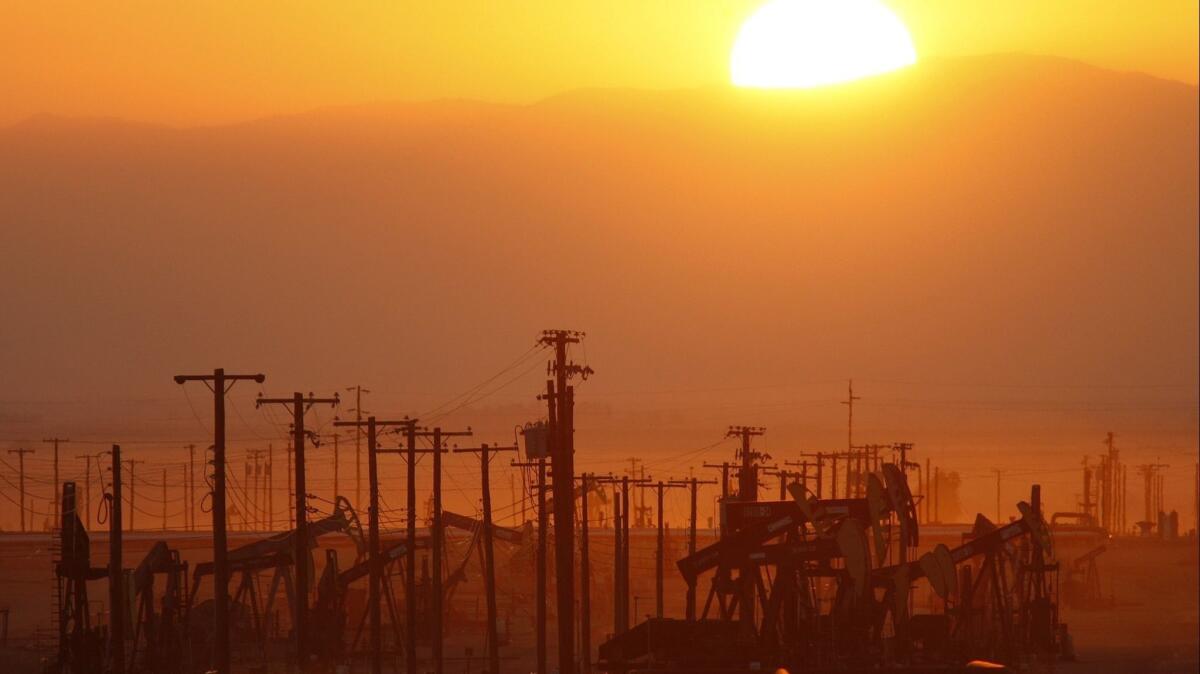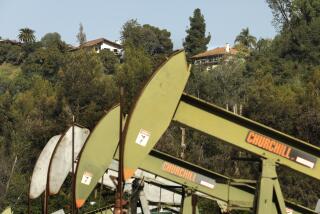Trump fracking plan targets over 1 million acres in California

Reporting from Washington — The Trump administration on Thursday detailed its plan to open more than a million acres of public and private land in California to fracking, raising environmental concerns at a time when opposition to oil and gas drilling in the state is intensifying.
The action would end a five-year moratorium on leasing federal land in California to oil and gas developers. That pause came after a federal judge ordered the Obama administration to halt similar leasing efforts until it could better evaluate the environmental risks of hydraulic fracturing, also known as fracking.
Trump’s plan – first proposed by the administration in 2018 — targets public and private land spread across eight counties in Central California: eastern Fresno, western Kern, Kings, Madera, San Luis Obispo, Santa Barbara, Tulare and Ventura.
The move drew immediate criticism from environmentalists, who said it would pose health risks and worsen air quality in a part of the state notorious for pollution.
“The Central Valley has some of the worst air quality in the nation, and we know fracking and drilling make air quality worse,” said Clare Lakewood, a senior attorney at the Center for Biological Diversity, an environmental advocacy group.
Lakewood said Trump’s plan would unleash a “fracking frenzy” that would endanger people and wildlife alike.
Once a plan is finalized and approved, environmental groups are expected to sue to block it, as they have in the past.
Proposed by the Bureau of Land Management, the plan is only the latest in a series of attempts by the federal government to open public land in Central California to fracking.
In 2013, a federal judge ruled that the government had violated the National Environmental Policy Act when it issued oil leases in Monterey County without analyzing the environmental dangers of fracking. Three years later, another federal judge reached a similar conclusion.
Now the Trump administration is trying to breathe new life into the proposal, part of its nationwide campaign to promote domestic energy production.
Industry groups praised the move. Kathleen Sgamma, president of the Western Energy Alliance, an association of independent oil and gas companies, said environmentalists’ fears were misguided.
“We’re not talking about a national park. We’re not talking about a wilderness area,” she said. “These are lands that the Obama administration affirmed are appropriate for carefully controlled development.”
The plan encompasses more than 1 million acres of federal mineral rights, including about 400,000 acres of land controlled by the bureau, according to the environmental impact statement released Thursday. In so-called split-estate parcels, the BLM owns the underlying mineral rights while another entity owns the property’s surface.
Mark Rose, a field representative for the National Parks Conservation Assn., said the proposal is concerning because it includes so much territory, some of which borders pristine forestland like Yosemite and Sequoia national parks.
“When you open up ... this wide swath of land, it really scares us that wells could be drilled right next to a national park like Sequoia, which is already one of the most polluted parks in the country for air pollution,” Rose said.
Some of the parcels in the plan are also adjacent to Los Padres National Forest, Carrizo Plain National Monument and the Wind Wolves Preserve.
Jeff Kuyper, executive director of Los Padres ForestWatch, said the BLM’s original maps of leasing areas were not very precise. When better maps were developed, “We realized that lo and behold, several of the Central Coast’s iconic landmarks and places near and dear to people who live there were on the chopping block.”
Among the parcels of concern are the grounds of public and private schools, land next to the Hopper Mountain National Wildlife Refuge in Ventura County and an area in Point Mugu State Park in the Santa Monica Mountains. Some of the potentially leased land is also along the Pacific Crest Trail in the southern Sierra Nevada.
“This plan is going to wind up in court unless the BLM makes some hard decisions about what is appropriate and not appropriate” to lease, Kuyper said. “They should look at it by parcel-by-parcel impact.”
He said the Army has raised concerns because some National Guard training properties would be open for drilling and fracking under the plan.
The Trump administration’s attempt to revive the plan could collide with efforts in California to limit fossil fuel development. Environmentalists are urging Gov. Gavin Newsom to ban new oil and gas drilling. Though this would not directly affect federally controlled land, it could affect state and privately owned land that falls within the agency’s plans.
The public will have 45 days to weigh in on the agency’s proposal.
Times staff writer Bettina Boxall in Los Angeles contributed to this report.
More stories from Anna M. Phillips »
More to Read
Get the L.A. Times Politics newsletter
Deeply reported insights into legislation, politics and policy from Sacramento, Washington and beyond. In your inbox three times per week.
You may occasionally receive promotional content from the Los Angeles Times.











